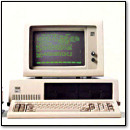[ Retro Scan of the Week ] Low-End Virtual Reality
Tuesday, January 7th, 2014 Every new idea is an old idea with more transistors.
Every new idea is an old idea with more transistors.
A few years ago, a relative gave me a couple issues of PCVR Magazine, a low-circulation 1990s periodical dedicated to virtual reality. Here’s the cover of the Jan/Feb 1994 issue, which features an illustration of the magazine’s build-it-yourself head tracker project.
In the early 1990s, the “virtual reality” concept hit a peak in the popular media that coincided with dozens of companies pursuing motion-tracking head-mounted displays — both with honest attempts and blatant gimmicks.
If I had to guess why VR exploded in the popular tech consciousness at that particular time, I would trace it it to the emergence of small, relatively low-cost color LCDs — the kind that made portable consoles like the Atari Lynx and Sega Game Gear possible. Compared to bulky, power-hungry CRT displays, the (relatively) thin, low-power LCDs could be worn on the head with mobility and without too much discomfort. That prompted a minor Cambrian explosion of VR headset hardware.
But the display technology just wasn’t there yet. Affordable LCDs were very low resolution (think 320×200 or less), and higher-resolution LCDs cost thousands of dollars a piece.
In addition, the hardware and software required to generate convincing virtual reality experiences were neither affordable nor generally available. So genuinely immersive VR found itself stuck in corporate and university research labs; meanwhile, the public got trickle-down fad headsets like the Stuntmaster.
Today, we find ourselves in the middle of a VR renaissance thanks to Oculus Rift. But this time, we may actually be at the edge of mainstream virtual reality headsets because the technology has come quite a long way since 1994. I look forward to meeting your 3D virtual avatar in cyberspace soon.
Discussion Topic of the Week: Have you ever used a virtual reality headset of any kind? Tell us about it.
—
See Also: Retro Scan of the Week Special Edition: “At Last! Reality For the Masses!” (VC&G, 2007)
See Also: The History of Stereoscopic 3D Gaming (PC World, 2011)













